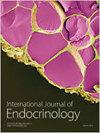较高的血浆致动脉粥样硬化指数与高尿酸血症有关:一项全国纵向研究
IF 2.3
4区 医学
Q3 ENDOCRINOLOGY & METABOLISM
引用次数: 0
摘要
背景。血浆动脉粥样硬化指数(AIP)与高尿酸血症之间的关系仍不明确。本研究旨在探讨中国中老年人血浆动脉粥样硬化指数(AIP)与高尿酸血症之间的关系。研究方法数据集来自 2011 年和 2015 年进行的中国健康与退休纵向研究(CHARLS)调查。分别有 13,021 人参加了 2011 年的中国健康与退休纵向研究,7,017 人参加了 2011 年和 2015 年的中国健康与退休纵向研究。AIP和高尿酸血症的测量基于空腹血液检测。AIP与高尿酸血症之间的关联通过逻辑回归进行评估,非线性关联通过受限立方样条(RCS)进行检验。AIP 的临界点是通过接收者操作曲线(ROC)计算得出的。1 :采用倾向得分匹配(PSM)进一步探讨 AIP 与高尿酸血症之间的关系。结果在横断面研究中,发现 AIP 与高尿酸血症呈正相关。高尿酸血症的几率比(ORs)分别为 1.00(参考值)、1.52(1.10-2.10)、1.80(1.31-2.47)和 3.81(2.84-5.11)。使用 RCS 分析未发现非线性关联。在四年的随访中,共有 664 例高尿酸血症病例。高尿酸血症发病率为 9.5%。在完全调整后的纵向分析中,不同 AIP 四分位数的高尿酸血症 OR 分别为 1.00(参考值)、1.00(0.74-1.37)、1.59(1.20-2.11)和 2.55(1.94-3.35)。在 PSM 后的纵向分析中,单变量和多变量模型中高尿酸血症的 OR 分别为 1.91(1.45,2.51)和 1.92(1.45,2.54)。结论AIP可预测中国中老年人群的高尿酸血症患病率。本文章由计算机程序翻译,如有差异,请以英文原文为准。
Higher Atherogenic Index of Plasma Is Associated with Hyperuricemia: A National Longitudinal Study
Background. The association between atherogenic index of plasma (AIP) and hyperuricemia remains indistinct. This study was aimed to examine the relationship between AIP and hyperuricemia among the middle-aged and the elderly Chinese population. Methods. Datasets were retrieved from the China Health and Retirement Longitudinal Study (CHARLS) survey conducted in 2011 and 2015. 13,021 participants in the CHARLS in 2011 and 7,017 participants involved both in 2011 and 2015 were included, respectively. The measurement of AIP and hyperuricemia was based on the test of fasting blood. Association between AIP and hyperuricemia was assessed by logistic regression, and the nonlinear association was examined by restricted cubic splines (RCS). The cutoff point of AIP was calculated using receiver operator curve (ROC). 1 : 1 propensity score matching (PSM) was adopted to further explore the relationship between AIP and hyperuricemia. Results. In the section of a cross-sectional study, a positive association between AIP and hyperuricemia was found. The odds ratios (ORs) of hyperuricemia were 1.00 (reference), 1.52 (1.10–2.10), 1.80 (1.31–2.47), and 3.81 (2.84–5.11). Nonlinear association was not detected using RCS analysis. There were 664 hyperuricemia cases during the four years follow-up. The hyperuricemia prevalence was 9.5%. In the fully adjusted longitudinal analysis, the ORs for hyperuricemia across the quartiles of AIP were 1.00 (reference), 1.00 (0.74–1.37), 1.59 (1.20–2.11), and 2.55 (1.94–3.35), respectively. In the longitudinal analysis after PSM, the OR of hyperuricemia were 1.91 (1.45, 2.51) and 1.92 (1.45, 2.54) in the univariate and multivariate model, respectively. Conclusion. AIP can predict the prevalence of hyperuricemia in the Chinese middle-aged and elderly population.
求助全文
通过发布文献求助,成功后即可免费获取论文全文。
去求助
来源期刊

International Journal of Endocrinology
ENDOCRINOLOGY & METABOLISM-
CiteScore
5.20
自引率
0.00%
发文量
147
审稿时长
1 months
期刊介绍:
International Journal of Endocrinology is a peer-reviewed, Open Access journal that provides a forum for scientists and clinicians working in basic and translational research. The journal publishes original research articles, review articles, and clinical studies that provide insights into the endocrine system and its associated diseases at a genomic, molecular, biochemical and cellular level.
 求助内容:
求助内容: 应助结果提醒方式:
应助结果提醒方式:


